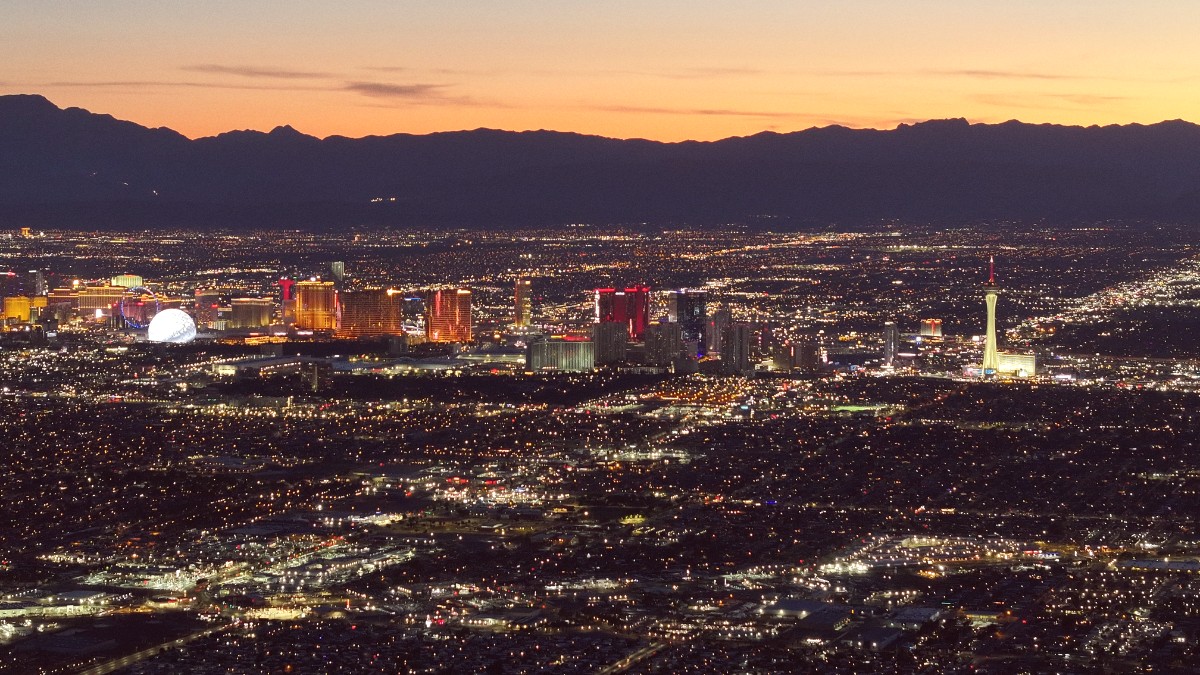
Nevada, USA
Harry Reid International Airport (LAS), formerly McCarran, is the main gateway to the Las Vegas Valley. Its location about 5 miles (8 kilometers) south of the Strip makes transfers relatively swift. LAS functions as a major aviation hub, serving millions annually. A wide array of airlines connect Las Vegas globally.
Flight prices and availability generally climb during peak travel seasons (Spring, Fall), major U.S. Holidays, and during large conventions. You find lower prices during off-peak times, like intense summer months or early winter (excluding New Year's). Flexibility with travel dates often leads to famous savings on airfare. LAS has two main terminals: Terminal 1 and Terminal 3, both offering amenities.
Taxis stand ready at designated airport stands. Flat rates apply for zone-based travel to the Strip. A central Strip ride typically runs $23-$27.
Uber and Lyft have specific pick-up areas. Follow airport signs to these designated zones. Fares fluctuate based on demand.
Bell Trans or Executive Limousine offer shared-ride services to most Strip hotels. These prove economical for solo travelers but take longer due to multiple stops.
No specific exit fees or taxes apply directly from the U.S. Government for departing travelers. Airport taxes typically get included in your airline ticket price at purchase time.
For international flights from LAS, arrive at least 3 hours prior. For domestic flights, arrive at least 2 hours prior. This allows ample time for check-in and security. Consider TSA PreCheck or CLEAR for faster security.
LAS offers diverse dining, shopping, lounges, restrooms, and free Wi-Fi. Gaming machines also stand available post-security, a final chance to try your luck.
Several long-distance bus companies offer services to and from Las Vegas, presenting an economical travel method from other U.S. cities. Greyhound connects from various cities. The Greyhound station sits downtown, requiring a short taxi, ride-share, or public bus link to the Strip. FlixBus provides intercity bus travel. Megabus operates routes from Los Angeles and other selected cities.
Renting a vehicle in Las Vegas offers flexibility, especially for extensive day trips outside the Strip. All major car rental companies operate here, including Avis, Budget, Enterprise, Hertz, National, Thrifty, Dollar, and Alamo. Most agencies sit at the McCarran Rent-A-Car Center, accessible via free airport shuttles.
Several specialty rental shops located off the Strip offer motorcycles and scooters. Requirements generally include a valid motorcycle endorsement on your driver's license (from your home country) and often a minimum age (e.g., 21 or 25). These present a different way to explore the open roads around Las Vegas.
Bicycle infrastructure directly on the Las Vegas Strip stays limited. Due to heavy vehicle traffic, large pedestrian crowds, and a lack of dedicated bike lanes, cycling on the Strip itself generally does not earn a recommendation for safety reasons. For recreational cycling, areas like the Clark County Wetlands Park, Lake Mead National Recreation Area, or Red Rock Canyon offer better and safer environments with dedicated trails.
Walking is a main means to experience the Las Vegas Strip, given its design for pedestrian traffic. The Strip itself features wide sidewalks, numerous pedestrian bridges, and escalators. These features assist in crossing busy intersections safely and efficiently. Many resorts interconnect, allowing indoor passage or via pedestrian walkways, offering a break from desert sun or cold.
Various independent companies offer guided walking tours focusing on specific aspects of Las Vegas, like its architecture, history, food scene, or specific resort properties. These tours provide local insights and a structured way to explore. You can also create self-guided tours using online maps or travel apps. Many online resources offer suggested walking routes for major attractions.
Distances between resorts on the Strip are deceptively long. Wear appropriate footwear for extensive walking.
The desert climate demands constant hydration. Carry a reusable water bottle and refill it often.
Always use sunscreen, a hat, and sunglasses, even on seemingly mild days.
Las Vegas presents several specialized transportation options that enhance the visitor experience, connecting resorts or offering unique city views. Big Bus Tours Las Vegas provides hop-on-hop-off routes covering the Strip and Downtown. This route offers a good way to see many sights at your own pace, with commentary on attractions. Many tour operators conduct bus tours from Las Vegas to major external attractions, like the Grand Canyon, Hoover Dam, and Red Rock Canyon.
Las Vegas aims for accessibility for all travelers. Most resorts, attractions, and public transport systems (RTC buses, Monorail) meet ADA compliance. They feature ramps, elevators, and accessible restrooms. Several third-party vendors in Las Vegas specialize in renting wheelchairs, electric scooters, and other mobility aids. You can often arrange for delivery and pick-up at your hotel.
The Las Vegas Strip features several free tram systems. These trams connect specific resorts, offering a way to move between properties without walking or needing a taxi.
The Mandalay Bay Tram links Mandalay Bay, Luxor, and Excalibur. The Aria Express Tram connects Park MGM, Aria, and Bellagio. The Mirage-Treasure Island Tram connects those two resorts.
The Venetian Resort provides iconic gondola rides (indoor and outdoor) along its simulated canals, offering a romantic and distinctive experience. These do not serve as transport between properties.
Use the free resort trams to conserve steps and energy when exploring connected properties. This small adjustment enhances your daily exploration.